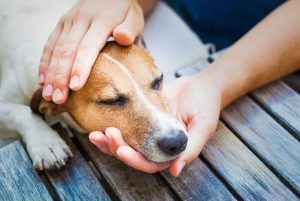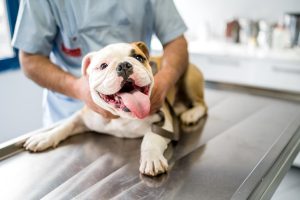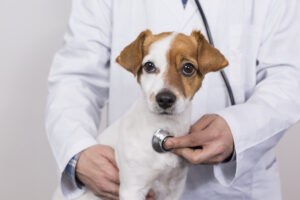Posts Tagged ‘vet’
Thanksgiving with Pets: The Do’s and Don’ts for Holiday Meals
 Thanksgiving is a time for gratitude, family, and of course, delicious food! While we love to include our furry friends in the celebration, it’s important to remember that not everything on the holiday table is safe for pets. At Olsen Veterinary Clinic, we want to help you and your pets enjoy a happy and healthy Thanksgiving together.
Thanksgiving is a time for gratitude, family, and of course, delicious food! While we love to include our furry friends in the celebration, it’s important to remember that not everything on the holiday table is safe for pets. At Olsen Veterinary Clinic, we want to help you and your pets enjoy a happy and healthy Thanksgiving together.
🐾 The Do’s: Safe Ways to Include Your Pets in the Feast
✅ Do share in moderation.
Small, plain portions of pet-safe foods can be a fun treat. Turkey meat (without skin or seasoning), plain green beans, carrots, or pumpkin puree are all healthy options — just keep portions small.
✅ Do keep their routine.
The excitement of guests and new smells can be stressful for pets. Stick to your pet’s regular feeding and walking schedule to keep them calm and comfortable throughout the day.
✅ Do create a quiet space.
If you’re hosting a large gathering, give your pet a quiet room to retreat to with their bed, water, and toys. This helps prevent anxiety and keeps them out of the kitchen chaos.
✅ Do secure the trash.
Thanksgiving leftovers can be tempting, but bones, string, and food wrappers can cause serious harm if swallowed. Make sure the trash is pet-proof and taken out promptly.
🚫 The Don’ts: Foods and Habits to Avoid
❌ Don’t feed turkey bones or skin.
Bones can splinter and cause choking or internal injuries. The skin is high in fat and may lead to pancreatitis, a painful and dangerous condition for dogs and cats.
❌ Don’t give foods with onions, garlic, or chives.
These ingredients, common in stuffing and gravy, are toxic to both dogs and cats and can cause serious digestive and blood problems.
❌ Don’t let them nibble on desserts.
Chocolate, xylitol (found in sugar-free treats), raisins, and grapes are all toxic to pets. Even a small amount can cause severe illness.
❌ Don’t forget about alcohol.
Even small sips of beer, wine, or cocktails can be dangerous for pets. Keep all drinks out of reach.
🐶 A Happy, Healthy Holiday
Thanksgiving can be a joyful experience for you and your pets when you plan ahead. Offer pet-safe treats, keep the dangerous foods off their plates, and stick to routines that make them feel secure.
If your pet gets into something they shouldn’t, contact Olsen Veterinary Clinic right away or reach out to the nearest emergency veterinary service. Quick action can make all the difference.
From all of us at Olsen Veterinary Clinic, we wish you and your furry family members a safe and wonderful Thanksgiving!
Springing Into Action: Preparing Your Pets for Warmer Weather
 As the days grow longer and temperatures rise, both you and your pets are likely eager to enjoy the great outdoors. However, with warmer weather comes a variety of seasonal risks, from fleas and ticks to overheating and outdoor hazards. At Olsen Veterinary Clinic, we want to ensure that your furry friends stay happy, healthy, and safe all season long. Here’s how you can prepare your pets for spring and summer fun.
As the days grow longer and temperatures rise, both you and your pets are likely eager to enjoy the great outdoors. However, with warmer weather comes a variety of seasonal risks, from fleas and ticks to overheating and outdoor hazards. At Olsen Veterinary Clinic, we want to ensure that your furry friends stay happy, healthy, and safe all season long. Here’s how you can prepare your pets for spring and summer fun.
Preventing Fleas, Ticks, and Other Pests
Fleas, ticks, and mosquitoes become more active as the weather warms up, posing serious health risks to pets. These pests can carry diseases such as Lyme disease, heartworm, and flea allergy dermatitis. Here are some key steps to keep them at bay:
- Use Preventative Treatments – Speak with your veterinarian about the best flea, tick, and heartworm preventatives for your pet. These can come in oral, topical, or collar form.
- Check for Pests Regularly – After spending time outside, inspect your pet’s coat, especially around the ears, neck, and paws, for ticks and fleas.
- Maintain a Clean Environment – Keep your yard mowed and free of standing water to reduce mosquito breeding grounds. Wash pet bedding frequently to prevent flea infestations.
Outdoor Safety Tips
Warmer weather encourages more outdoor adventures, but it’s essential to keep safety in mind:
- Provide Plenty of Water and Shade – Pets can easily overheat in the sun. Always have fresh water available and ensure they have a shady spot to rest.
- Be Cautious of Hot Surfaces – Pavement and sand can become scorching in the heat, potentially burning your pet’s paws. Walk them in the early morning or late evening when surfaces are cooler.
- Use Pet-Safe Sunscreen – Dogs and cats with light-colored fur or exposed skin can get sunburned. Use a pet-safe sunscreen to protect them.
- Secure Your Yard and Outdoor Spaces – Check for any gaps in fences, toxic plants, or harmful garden chemicals that could pose a risk to your pet.
Seasonal Allergies and Grooming
Just like humans, pets can suffer from seasonal allergies. Pollen, grass, and mold can cause itching, sneezing, and discomfort. Keep an eye out for excessive scratching, red skin, or ear infections. Regular grooming, including bathing and brushing, can help remove allergens from their coat. If symptoms persist, consult your veterinarian for allergy relief options.
By taking these proactive steps, you can ensure your pet enjoys a safe and comfortable transition into the warmer months. If you have any concerns or need personalized recommendations, don’t hesitate to contact Olsen Veterinary Clinic. Here’s to a happy and healthy spring and summer for you and your beloved pets!
How to Identify Signs of Pain in Pets: A Guide by Olsen Veterinary Clinic
 As pet owners, we deeply care about the well-being of our furry companions. However, unlike humans, pets can’t express their pain in words, making it challenging for us to recognize when something is wrong. Identifying signs of pain in pets is crucial to ensuring they receive prompt medical attention and live a happy, healthy life. At Olsen Veterinary Clinic, we encourage pet owners to be vigilant and aware of subtle signs of pain or discomfort in their pets.
As pet owners, we deeply care about the well-being of our furry companions. However, unlike humans, pets can’t express their pain in words, making it challenging for us to recognize when something is wrong. Identifying signs of pain in pets is crucial to ensuring they receive prompt medical attention and live a happy, healthy life. At Olsen Veterinary Clinic, we encourage pet owners to be vigilant and aware of subtle signs of pain or discomfort in their pets.
Common Signs of Pain in Pets
- Changes in Behavior: One of the first indicators of pain in pets is a noticeable change in their behavior. You may observe that a typically active dog becomes lethargic, or a usually independent cat becomes clingy or irritable. Pets may also become withdrawn, hide more frequently, or avoid interaction with their favorite humans or other animals in the house.
- Vocalization: Though pets can’t talk, they may communicate discomfort through vocalizations. If your pet starts whining, yelping, growling, or meowing more than usual, especially when touched or moved, it may indicate pain. Some pets might also begin purring excessively (in the case of cats), which can be a self-soothing mechanism rather than a sign of contentment.
- Changes in Posture and Movement: Limping, stiffness, difficulty getting up or lying down, or reluctance to jump or climb stairs are telltale signs of physical discomfort. Pets in pain may also adopt unusual postures, such as hunching their back or tucking in their abdomen. If your dog or cat seems to favor a particular side or avoids using a limb, this could indicate an injury or joint pain.
- Decreased Appetite: A decrease in appetite is another common sign that your pet may be experiencing pain. If your pet suddenly becomes uninterested in food or water, it could be due to discomfort, dental pain, or an underlying health issue. Pay attention to any changes in eating or drinking habits and consult your veterinarian if the behavior persists.
- Excessive Grooming or Licking: Pets in pain often focus on the area of discomfort by excessively licking, biting, or grooming. Dogs might chew at their paws or limbs, while cats might over-groom one specific area. In some cases, this behavior can lead to hair loss, skin irritation, or infection.
- Changes in Breathing: Pain can cause changes in your pet’s breathing patterns. Rapid, shallow breathing or panting excessively when not overheated may be an indication of distress. Some pets may also develop an irregular heart rate or appear restless when trying to sleep.
- Unexplained Aggression or Fear: Even the most gentle and loving pets can exhibit aggression when they are in pain. If your pet suddenly starts growling, snapping, or hissing, especially when touched, this could be a defensive response to pain. Additionally, a pet that becomes unusually fearful or anxious in situations where they would typically be comfortable might be signaling they are in distress.
- Digestive Issues: Vomiting, diarrhea, or constipation can be indirect signs of pain, especially if accompanied by other behavioral changes. Gastrointestinal discomfort may also lead to restlessness or a reluctance to lie down, as certain positions may aggravate the pain.
When to Seek Veterinary Attention
If you notice any of these signs, it’s essential to contact a veterinarian as soon as possible. Pain is often a symptom of an underlying condition that requires medical attention. Whether it’s due to injury, arthritis, dental disease, or an internal issue, early diagnosis and treatment can prevent further complications and improve your pet’s quality of life.
At Olsen Veterinary Clinic, we understand how important it is to keep your pets healthy and comfortable. Our team is committed to providing compassionate care and expert guidance to help you navigate any health concerns your pet may experience. If you suspect your pet is in pain, don’t hesitate to bring them in for an examination. Together, we can ensure your furry family member stays happy, healthy, and pain-free.
Being attuned to your pet’s behavior and recognizing the signs of pain early on can make a significant difference in their well-being. By taking a proactive approach and seeking veterinary care when necessary, you can help your pet enjoy a longer, healthier life. If you have concerns about your pet’s health or believe they may be experiencing pain, Olsen Veterinary Clinic is here to assist you every step of the way.
Understanding Pet Vaccinations: Ensuring Your Pet’s Health
 As pet owners, we all want our furry companions to live long, healthy, and happy lives. One of the most crucial aspects of maintaining your pet’s health is ensuring they receive the appropriate vaccinations. At Olsen Veterinary Clinic, we believe in educating pet owners about the importance of vaccinations, the recommended vaccination schedule, and how these preventive measures contribute to your pet’s overall well-being.
As pet owners, we all want our furry companions to live long, healthy, and happy lives. One of the most crucial aspects of maintaining your pet’s health is ensuring they receive the appropriate vaccinations. At Olsen Veterinary Clinic, we believe in educating pet owners about the importance of vaccinations, the recommended vaccination schedule, and how these preventive measures contribute to your pet’s overall well-being.
Why Are Pet Vaccinations Important?
Vaccinations are vital for protecting pets from various infectious diseases, some of which can be life-threatening. These vaccines work by stimulating the immune system to recognize and fight specific pathogens, such as viruses and bacteria, if your pet is exposed to them in the future. Here are some key reasons why vaccinations are essential:
1. Disease Prevention
Vaccines help prevent numerous diseases that can affect pets. For example, canine parvovirus, distemper, and rabies in dogs, and feline leukemia virus and panleukopenia in cats, are all preventable through vaccination.
2. Public Health
Some diseases that affect pets, like rabies, can be transmitted to humans. By vaccinating your pet, you are also protecting yourself, your family, and your community from potential zoonotic diseases.
3. Legal Requirements
In many areas, certain vaccinations, such as rabies, are required by law. Ensuring your pet is up-to-date with their vaccines helps you stay compliant with local regulations.
4. Cost-Effective Health Care
Preventing diseases through vaccination is often far less expensive than treating the diseases once they occur. Regular vaccinations can save you from costly treatments and emergency vet visits.
Recommended Vaccination Schedule
At Olsen Veterinary Clinic, we follow a vaccination schedule that aligns with the guidelines set by veterinary health authorities. Here is a general outline of the recommended vaccination schedule for dogs and cats:
For Puppies and Dogs:
- 6-8 weeks:
- Distemper
- Parvovirus
- Adenovirus (Hepatitis)
- Parainfluenza
- 10-12 weeks:
- Booster for Distemper, Parvovirus, Adenovirus, and Parainfluenza
- Bordetella (Kennel Cough)
- 14-16 weeks:
- Booster for Distemper, Parvovirus, Adenovirus, and Parainfluenza
- Rabies
- 1 year and annually thereafter:
- Annual boosters for Distemper, Parvovirus, Adenovirus, Parainfluenza, and Rabies
- Optional: Lyme disease, Leptospirosis, and Influenza based on your dog’s risk factors
For Kittens and Cats:
- 6-8 weeks:
- Feline Viral Rhinotracheitis (FVR)
- Calicivirus (FCV)
- Panleukopenia (FPV)
- 10-12 weeks:
- Booster for FVR, FCV, and FPV
- Feline Leukemia Virus (FeLV)
- 14-16 weeks:
- Booster for FVR, FCV, FPV, and FeLV
- Rabies
- 1 year and annually thereafter:
- Annual boosters for FVR, FCV, FPV, FeLV, and Rabies
How Vaccinations Contribute to Your Pet’s Well-Being
Regular vaccinations play a crucial role in maintaining your pet’s overall health and well-being. Here’s how:
1. Boosts Immunity
Vaccines strengthen your pet’s immune system, making them more capable of fighting off infections and reducing the severity of illnesses if they do occur.
2. Reduces Disease Spread
By vaccinating your pets, you are helping to control the spread of contagious diseases within the pet population. This is particularly important in communal settings like parks, boarding facilities, and grooming salons.
3. Improves Quality of Life
Healthy pets are happy pets. Vaccinations protect against debilitating diseases that can significantly reduce your pet’s quality of life, ensuring they stay active and vibrant.
4. Longevity
Preventive care, including regular vaccinations, has been proven to extend the lifespan of pets. By safeguarding them against diseases, you are giving your pet the best chance at a long, healthy life.
At Olsen Veterinary Clinic, we are committed to providing the highest standard of care for your pets. Vaccinations are a cornerstone of preventive health care, and we encourage all pet owners to adhere to the recommended vaccination schedules. By doing so, you are not only protecting your pet but also contributing to the overall health of the animal community.
If you have any questions about your pet’s vaccination needs or would like to schedule an appointment, please contact us at Olsen Veterinary Clinic. Together, we can ensure your pet’s health and happiness for years to come.
The Importance of Regular Veterinary Check-ups
 Regular veterinary check-ups are crucial for maintaining the overall health and well-being of your pets. These routine visits play a key role in preventative care and early detection of health issues. Here are some reasons why regular veterinary check-ups are important.
Regular veterinary check-ups are crucial for maintaining the overall health and well-being of your pets. These routine visits play a key role in preventative care and early detection of health issues. Here are some reasons why regular veterinary check-ups are important.
Preventative Care:
Regular check-ups allow veterinarians to administer vaccinations, parasite control, and dental care. Preventative measure can help protect your pet from various illnesses, ensuring they lead a healthier longer life.
Early Detection of Health Issues:
Pets, like humans, can develop health issues that may not be immediately apparent. Regular check-ups enable veterinarians to detect potential health problems early, often before symptoms become severe. Early detection can significantly improve the prognosis and treatment outcomes.
Disease Screening:
Veterinary check-ups may include screenings and tests for common pet diseases. These screenings can help identify conditions such as diabetes, kidney disease, and certain types of cancer in their early stages, allowing for timely intervention.
Dental Health:
Dental issues are common in pets, and they can lead to various health problems if left untreated. Regular veterinary visits often include dental examinations and cleanings, promoting good oral health and preventing dental diseases.
Nutritional Guidance:
Veterinarians can provide guidance on proper nutrition based on your pet’s age, breed, and health condition. A well-balanced diet is essential for maintaining your pet’s overall health and preventing nutrition-related issues.
Behavioral Assessment:
Veterinarians can assess your pet’s behavior during routine visits. Changes in behavior may be indicative of underlying health issues and addressing them early can prevent further complications.
Weight Management:
Maintaining a healthy weight is crucial for your pet’s well-being. Regular check-ups allow veterinarians to monitor your pet’s weight and provide guidance on nutrition and exercise to prevent obesity-related health issues.
Senior Pet Care:
As pets age, their healthcare needs may change. Regular check-ups become even more critical for senior pets to monitor and address age-related conditions, such as arthritis, dental problems, and organ dysfunction.
Client Education:
Veterinary visits are an opportunity for pet owners to learn about their pet’s specific needs, behaviors, and potential health risks. Education from veterinarians empowers pet owners to provide the best care possible.
In summary, regular veterinary check-ups are essential for preventative care, early detection of health issues, and ensuring that your pets lead healthy and happy lives. Establishing a consistent schedule of veterinary visits can contribute significantly to the overall well-being of your beloved companions. Contact our office today to schedule yours or if you have any questions.
Is My Cat Sleeping Too Much? How to Know the Difference Between a Cat Nap and a Problem
 Cats are known for sleeping a lot, and it’s perfectly normal for them to spend a significant portion of their day napping. On average, cats can sleep anywhere from 12 to 16 hours a day and some cats may sleep even more, especially if they are very young or very old. However, if you’re concerned that your cat is sleeping too much and it might be a sign of a problem, here are some things to consider:
Cats are known for sleeping a lot, and it’s perfectly normal for them to spend a significant portion of their day napping. On average, cats can sleep anywhere from 12 to 16 hours a day and some cats may sleep even more, especially if they are very young or very old. However, if you’re concerned that your cat is sleeping too much and it might be a sign of a problem, here are some things to consider:
- Changes in Behavior: Pay attention to any noticelable changes in your cat’s behavior. If your cat is typically active, playful, and social when awake but suddenly becomes lethargic or withdrawn, it could be a sign of an underlying issue.
- Appetite and Thirst: Monitor your cat’s eating and drinking habits. A significant decrease in appetite or a noticeable increase in thirst can be indicators of a health problem.
- Weight Changes: Sudden weight loss or gain can be a sign of various health issues, so keep an eye on your cat’s weight.
- Bathroom Habits: Changes in litter box habits, such as straining to urinate, diarrhea, or constipation, may indicate a problem. Also, observe the color and consistency of your cat’s urine and feces.
- Physical Symptoms: Look for physical signs of distress, such as vomiting, coughing, sneezing, limping, or any obvious discomfort or pain. These can be clues that something is amiss.
- Age and Health History: The age and overall health of your cat can also influence their sleeping patterns. Senior cats may sleep more than younger cats. Consult with your veterinarian to discuss age-related changes in your cat’s behavior.
- Environmental Factors: Ensure your cat’s environment is comfortable and stress-free. Changes in your cat’s living situation, such as moving to a new home, introducing a new pet, or household routine, can affect their behavior and sleep patterns.
- Regular Veterinary Check-Ups: Regular veterinary check-ups are essential for maintaining your cat’s health. If you’re concerned about your cat’s excessive sleeping or any other changes, consult your veterinarian. They can perform a physical examination, run diagnostic tests, and provide guidance of your cat’s specific needs.
Obviously, you know your cat better than anyone. So if you have any concerns or questions about your fur baby, don’t hesitate to contact our office today to set up a visit.
Should Your Dog Get a Choker Collar? Here’s What You Need to Know
 Whether or not your dog should wear a chain choker collar is a matter of debate among dog trainers, veterinarians, and animal welfare organizations. There are several factors to consider before deciding to use a chain choker collar:
Whether or not your dog should wear a chain choker collar is a matter of debate among dog trainers, veterinarians, and animal welfare organizations. There are several factors to consider before deciding to use a chain choker collar:
1 Training Methodology: Chain choker collars are often used in training as a correction tool. However, they are associated with aversive training methods that rely on punishing undesirable behaviors through discomfort or pain. Many modern dog trainers advocate for positive reinforcement-based training methods, which focus on rewarding desired behaviors rather than punishing unwanted ones.
2 Breed and Size of the Dog: Smaller or more delicate dog breeds may be more vulnerable to injury when using chain choker collars. Breeds with thin necks, like Greyhounds, may be at a higher risk.
3 Health and Behavior Issues: Some dogs may have underlying health issues or behavioral problems that make the use of chain choker collars risky or inappropriate. For example, dogs with respiratory problems, brachycephalic breeds (i.e., Bulldogs), or fearful and aggressive should not be subjected to such collars.
4 Training Experience: If you are not experienced in using chain choker collars correctly, there is a risk of causing harm to your dog or reinforcing negative behaviors unintentionally. It is crucial to learn how to use these collars properly if you choose to use them.
5 Alternatives: There are many alternative training tools and methods available that can effectively train dogs without resorting to aversive methods. Positive reinforcement, clicker training, and head halters are examples of more humane and effective training tools.
6 Consultation with a Professional: If you are considering using a chain choker collar, it is strongly recommended that you consult with a professional dog trainer or behavioralist who can assess your dog’s specific needs and help you make an informed decision.
7 Local Laws and Regulations: Some places have laws and regulations that restrict or even ban the use of certain dog collars, including chain choker collars. Be sure to check your local laws and follow them accordingly.
If you have any questions about this or anything else, don’t hesitate to contact our office.
National Mutt Day: Here Are Some Ways To Celebrate
 Question of the month. What do Higgins ( the dog from the film Benji) , Laika ( the Soviet space dog), Pluto (Mickey Mouses’s pet dog) and Clifford the Big Red Dog all have in common? Believe it or not, they are all famous mixed-breed dogs and on July 31, it is National Mutt Day.
Question of the month. What do Higgins ( the dog from the film Benji) , Laika ( the Soviet space dog), Pluto (Mickey Mouses’s pet dog) and Clifford the Big Red Dog all have in common? Believe it or not, they are all famous mixed-breed dogs and on July 31, it is National Mutt Day.
National Mutt Day, also known as National Mixed Breed Dog Day, is a day dedicated to celebrating mixed breed dogs and raising awareness about their value as pets. It is observed on two different dates throughout the year: July 31st and December 2nd.
On National Mutt Day, people are encouraged to adoopt mixed breed dogs from animal shelters and rescue organizations rather than buying from breeders. The day aims to promote the adoption and well-being of mixed breed dogs and to combat the stigma and misconceptions surrounding them.
Mixed breed dogs, often referred to as mutts, are dogs that have a combination of different breeds in their ancestry. They can exhibit a wide range of characteristics, both in terms of appearance and temperament. Adopting a mutt can be a rewarding experience, as they often have unique and diverse traits.
If you are interested in celebrating National Mutt Day, you can consider doing the following:
- Visit your local animal shelter or rescue organization: Spend some time with the mixed breed dogs available for adoption, and consider bringing one into your family if it is the right fit for you.
- Volunteer at an animal shelter: Offer your time and help by volunteering at a local shelter. You can assist with walking the dogs, cleaning their encolosures, or providing general care.
- Spread awareness: Use your social media platforms to share information about National Mutt Day and the benefits of adopting mixed breed dogs. Encourage others to consider adopting a mutt or donate to local animal welfare organinzations.
- Organize an event: Consider organizing an event in your community that promotes adoption and celebrates mixed breed dogs. This could include activities such as doggie playdates, training sessions, or informational sessions about responsible pet ownership.
Here at Olsen Veterinary Clinic, we take pride in taking care of EVERY animal, no matter the breed or type. If you have any questions about your pet, don’t hesitate to contact our office today!
Tips to Keep Your Pets Safe this Independence Day
 A lot of people will be celebrating Independence Day on July 4th. It is important to think about our pets also and plan ahead. As much as we like a fun time celebrating, a lot of pets are scared to death with the fireworks and crowds. It is important to talk to your veterinarian about possibly getting some sedatives to relieve the anxieties associated with them and get advise from them to find out what might be best. It is best to leave your pets inside with the shades pulled down and maybe the tv or radio playing to try and muffle the explosions of the fireworks. Several communities have firework shows that are fantastic to watch, however LEAVE YOUR PET AT HOME. The loud reports can scare the pets and make them a nervous wreck.
A lot of people will be celebrating Independence Day on July 4th. It is important to think about our pets also and plan ahead. As much as we like a fun time celebrating, a lot of pets are scared to death with the fireworks and crowds. It is important to talk to your veterinarian about possibly getting some sedatives to relieve the anxieties associated with them and get advise from them to find out what might be best. It is best to leave your pets inside with the shades pulled down and maybe the tv or radio playing to try and muffle the explosions of the fireworks. Several communities have firework shows that are fantastic to watch, however LEAVE YOUR PET AT HOME. The loud reports can scare the pets and make them a nervous wreck.
Talking about celebrations, there is usually a lot of good food for people, but avoid allowing your pet to counter surf and eat the table food. Some foods such as grapes are toxic for pets, while other greasy and fatty foods may lead to a gastric illness like pancreitis. These illnesses might then require a trip to see your veterinarian and possibly be costly and deadly.
If you and your family are around water during the holiday, it is important to have a life jacket handy for your pet, as not all dogs are great swimmers. Whether it is on a lake or in the pool, the dogs may tire and then start to struggle and panic. A life jacket for your pet may be able to keep your pet safe.
We are happy to have a conversation about any concerns you have. Make sure to protect your furry companion this summer. Contact our offices today!
New Puppy Checklist: Everything You Need Before Welcoming Your New Furry Friend into Your Life
 Bringing a new puppy into your home is an exciting time but requires some preparation for your home. Puppies require a lot of attention and care, so this checklist will be beneficial if you are unsure where to start with the basics for your new puppy.
Bringing a new puppy into your home is an exciting time but requires some preparation for your home. Puppies require a lot of attention and care, so this checklist will be beneficial if you are unsure where to start with the basics for your new puppy.
Some companies have created puppy starter kits. For example, this box made by Chewy has a set of toys, treats, and potty-training materials to help you with your new puppy. All top-rated items, new puppy owners are sure to appreciate it. It also makes a great gift. It can be found here.
Beyond toys, treats, and potty-training materials, puppies need food and water bowls. There are a lot of different options, but one that is slightly lifted is easier for your puppy to eat from. If you get one with walls, it is more likely your floor will stay cleaner.
Also necessary is a bed for your pet. An elevated bed is good for keeping your dog lifted and is helpful for teaching different cues. Other more traditional options are great too, especially as your pups are growing quickly.
Some owners choose to crate their puppies, and there are a lot of options but must be replaced as dogs grow. Crates help dogs have a safe place, especially as they adjust to a new space and lifestyle.
Also important for your new puppy is a leash. There are many kinds of leashes, with different uses. It will most likely be trial and error to find what works for you and your puppy, so be prepared for a trial period.
Puppies require hygiene efforts. This includes toothbrushes, toothpaste, nail clippers, brushes, and bathing supplies. Providing exposure to these items while young makes it less scary for adult dogs and easier for their owners.
Lastly, a collar is a great way to express your and your pet’s personality. Be prepared for your new pup with a collar and tag to provide some protection and peace of mind.
The last step for a new puppy is establishing an appointment with your veterinarian to get started on vaccinations and discuss your new dog’s life! Feel free to contact Dr. Olsen of Olsen Veterinary Clinic at 618-656-5868 to set up an appointment or discuss any questions!
